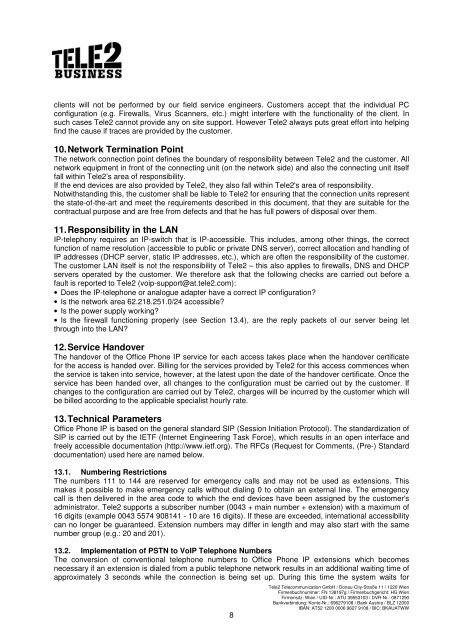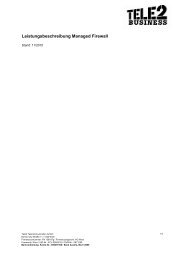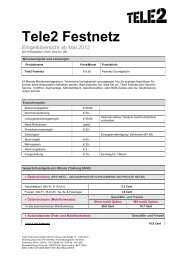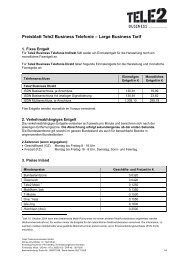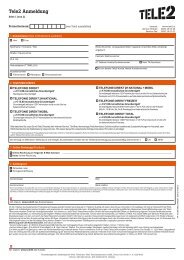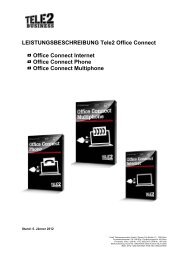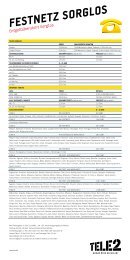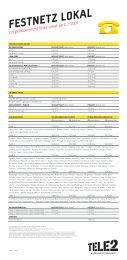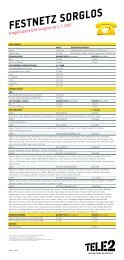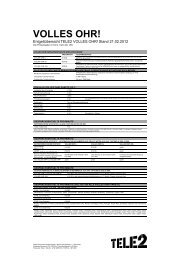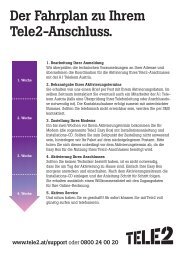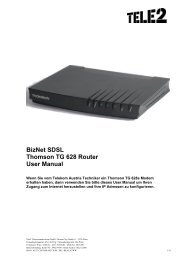Description of Services Tele2 Office Phone IP (Status: 09/2011)
Description of Services Tele2 Office Phone IP (Status: 09/2011)
Description of Services Tele2 Office Phone IP (Status: 09/2011)
Create successful ePaper yourself
Turn your PDF publications into a flip-book with our unique Google optimized e-Paper software.
clients will not be performed by our field service engineers. Customers accept that the individual PC<br />
configuration (e.g. Firewalls, Virus Scanners, etc.) might interfere with the functionality <strong>of</strong> the client. In<br />
such cases <strong>Tele2</strong> cannot provide any on site support. However <strong>Tele2</strong> always puts great effort into helping<br />
find the cause if traces are provided by the customer.<br />
10. Network Termination Point<br />
The network connection point defines the boundary <strong>of</strong> responsibility between <strong>Tele2</strong> and the customer. All<br />
network equipment in front <strong>of</strong> the connecting unit (on the network side) and also the connecting unit itself<br />
fall within <strong>Tele2</strong>’s area <strong>of</strong> responsibility.<br />
If the end devices are also provided by <strong>Tele2</strong>, they also fall within <strong>Tele2</strong>'s area <strong>of</strong> responsibility.<br />
Notwithstanding this, the customer shall be liable to <strong>Tele2</strong> for ensuring that the connection units represent<br />
the state-<strong>of</strong>-the-art and meet the requirements described in this document, that they are suitable for the<br />
contractual purpose and are free from defects and that he has full powers <strong>of</strong> disposal over them.<br />
11. Responsibility in the LAN<br />
<strong>IP</strong>-telephony requires an <strong>IP</strong>-switch that is <strong>IP</strong>-accessible. This includes, among other things, the correct<br />
function <strong>of</strong> name resolution (accessible to public or private DNS server), correct allocation and handling <strong>of</strong><br />
<strong>IP</strong> addresses (DHCP server, static <strong>IP</strong> addresses, etc.), which are <strong>of</strong>ten the responsibility <strong>of</strong> the customer.<br />
The customer LAN itself is not the responsibility <strong>of</strong> <strong>Tele2</strong> – this also applies to firewalls, DNS and DHCP<br />
servers operated by the customer. We therefore ask that the following checks are carried out before a<br />
fault is reported to <strong>Tele2</strong> (voip-support@at.tele2.com):<br />
• Does the <strong>IP</strong>-telephone or analogue adapter have a correct <strong>IP</strong> configuration?<br />
• Is the network area 62.218.251.0/24 accessible?<br />
• Is the power supply working?<br />
• Is the firewall functioning properly (see Section 13.4), are the reply packets <strong>of</strong> our server being let<br />
through into the LAN?<br />
12. Service Handover<br />
The handover <strong>of</strong> the <strong>Office</strong> <strong>Phone</strong> <strong>IP</strong> service for each access takes place when the handover certificate<br />
for the access is handed over. Billing for the services provided by <strong>Tele2</strong> for this access commences when<br />
the service is taken into service, however, at the latest upon the date <strong>of</strong> the handover certificate. Once the<br />
service has been handed over, all changes to the configuration must be carried out by the customer. If<br />
changes to the configuration are carried out by <strong>Tele2</strong>, charges will be incurred by the customer which will<br />
be billed according to the applicable specialist hourly rate.<br />
13. Technical Parameters<br />
<strong>Office</strong> <strong>Phone</strong> <strong>IP</strong> is based on the general standard S<strong>IP</strong> (Session Initiation Protocol). The standardization <strong>of</strong><br />
S<strong>IP</strong> is carried out by the IETF (Internet Engineering Task Force), which results in an open interface and<br />
freely accessible documentation (http://www.ietf.org). The RFCs (Request for Comments, (Pre-) Standard<br />
documentation) used here are named below.<br />
13.1. Numbering Restrictions<br />
The numbers 111 to 144 are reserved for emergency calls and may not be used as extensions. This<br />
makes it possible to make emergency calls without dialing 0 to obtain an external line. The emergency<br />
call is then delivered in the area code to which the end devices have been assigned by the customer's<br />
administrator. <strong>Tele2</strong> supports a subscriber number (0043 + main number + extension) with a maximum <strong>of</strong><br />
16 digits (example 0043 5574 908141 - 10 are 16 digits). If these are exceeded, international accessibility<br />
can no longer be guaranteed. Extension numbers may differ in length and may also start with the same<br />
number group (e.g.: 20 and 201).<br />
13.2. Implementation <strong>of</strong> PSTN to Vo<strong>IP</strong> Telephone Numbers<br />
The conversion <strong>of</strong> conventional telephone numbers to <strong>Office</strong> <strong>Phone</strong> <strong>IP</strong> extensions which becomes<br />
necessary if an extension is dialed from a public telephone network results in an additional waiting time <strong>of</strong><br />
approximately 3 seconds while the connection is being set up. During this time the system waits for<br />
8<br />
<strong>Tele2</strong> Telecommunication GmbH / Donau-City-Straße 11 / 1220 Wien<br />
Firmenbuchnummer: FN 138197g / Firmenbuchgericht: HG Wien<br />
Firmensitz: Wien / UID-Nr.: ATU 39553103 / DVR-Nr.: 0871290<br />
Bankverbindung: Konto-Nr.: 696279108 / Bank Austria / BLZ 12000<br />
IBAN: AT52 1200 0006 9627 9108 / BIC: BKAUATWW


